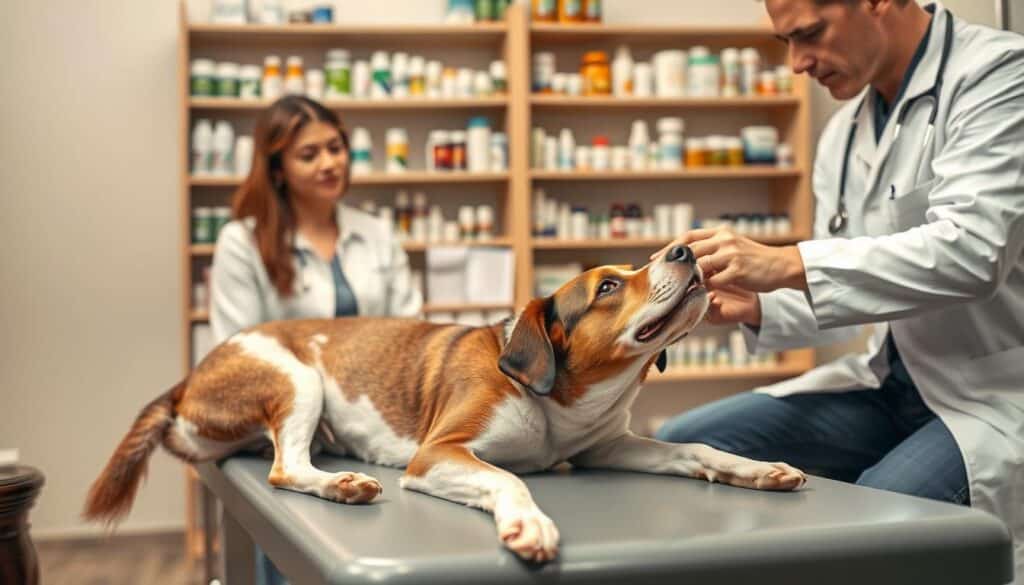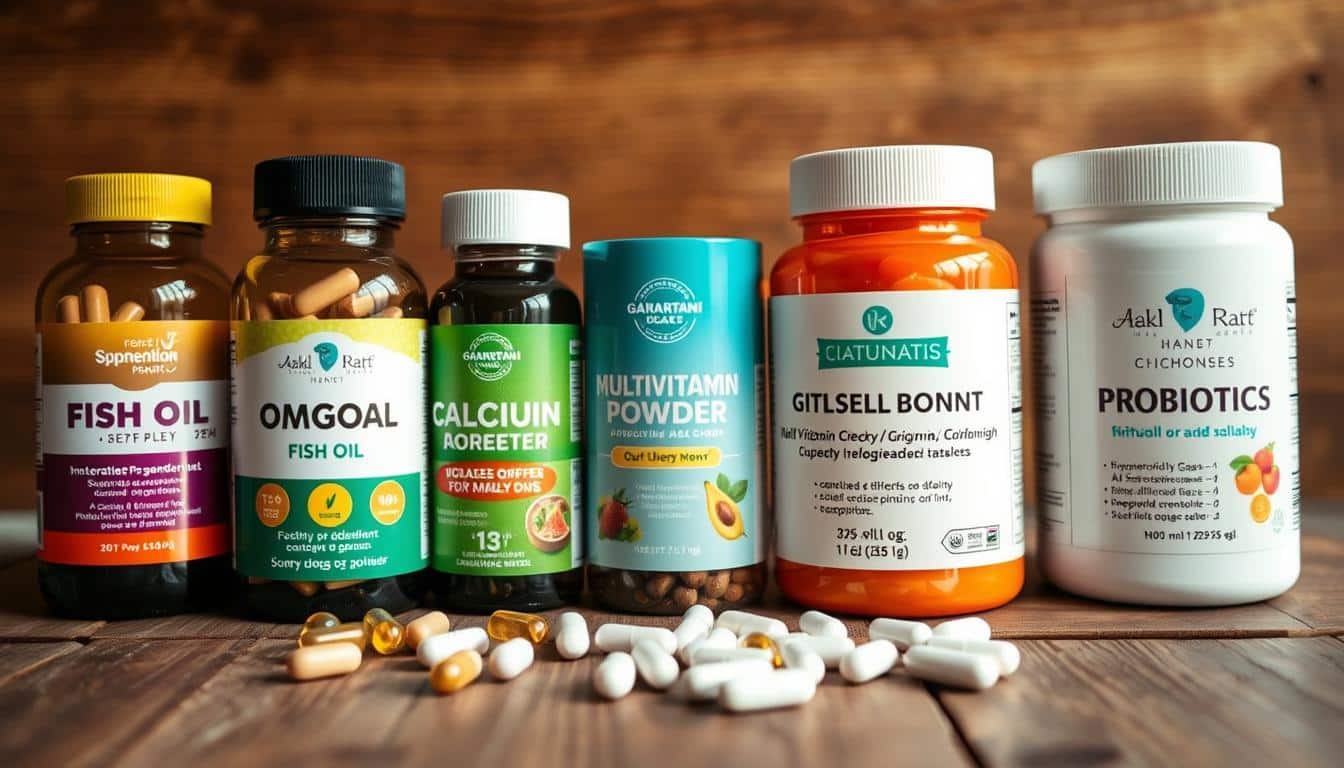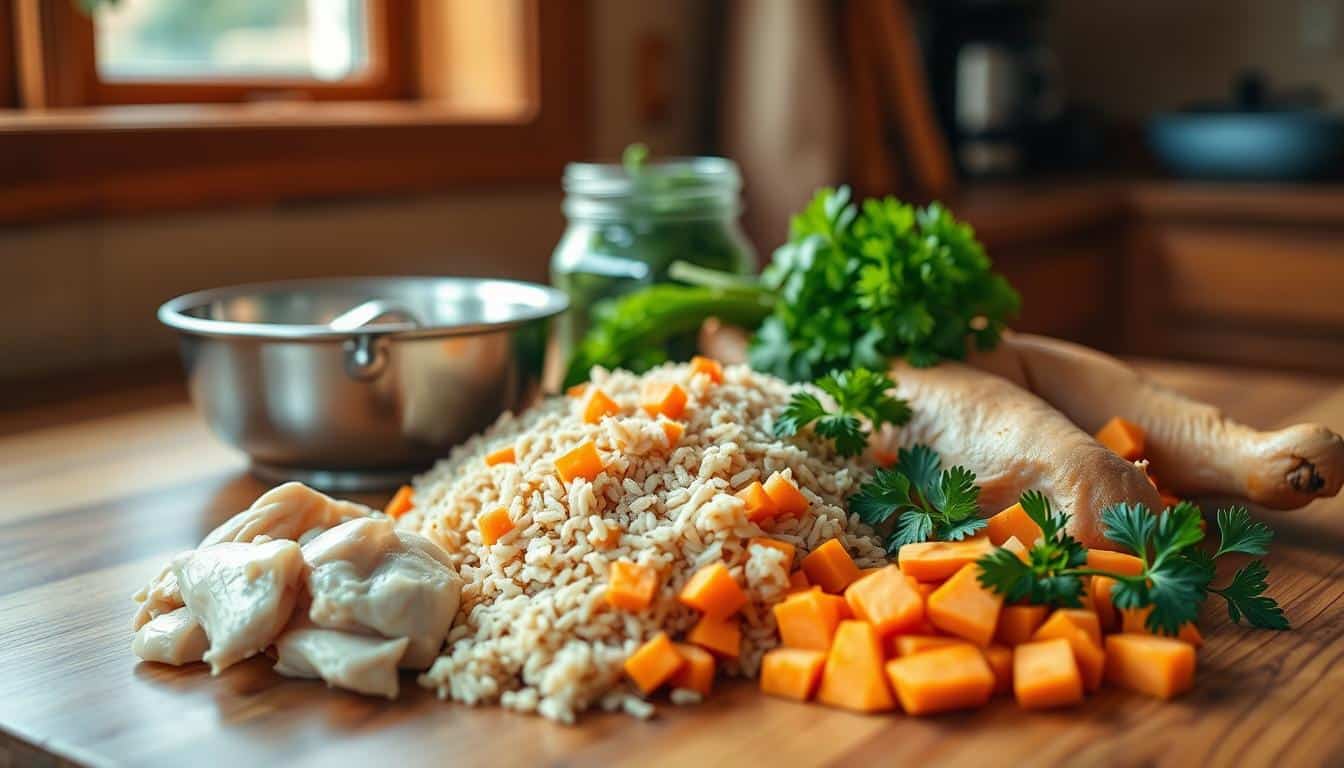Food can cause skin and gut problems in dogs. This vet-safe diet plan helps find and handle dog food allergies. It aims to boost their overall health.
Always talk to your vet before making changes. They’re key in finding the right diagnosis and treatment. This includes choosing special diets or making homemade food correctly.
This Heal Pets diet plan gives you easy steps and rules for food trials. It teaches about bland diets (like boiled chicken and rice) and using probiotics. It also tells you when to get emergency help for serious symptoms.
This guide offers tips on managing dog allergies through food. It discusses how vets use special diets and ways to make food trials successful at home.
Understanding Canine Food Allergies and Cutaneous Adverse Food Reactions
Dogs with skin and gut issues may face a special problem. It’s different from the quick food allergies seen in humans. This condition shows up slowly, sometimes weeks after the dog eats something it’s sensitive to.
It’s important for dog owners to understand this distinction. It helps in getting the right help for their furry friends.
Dog allergy symptoms mainly affect the skin. Signs include non-stop itching, a lot of licking, and rubbing. Dogs often develop hot spots from this.
These skin issues can lead to ear infections and other problems caused by bacteria or yeast.
Along with skin problems, some dogs have stomach issues. This includes throwing up, diarrhea, and extra gas. If a dog has skin and stomach troubles, food might be causing it.
- Itching and generalized pruritus
- Recurrent otitis externa (ear infections)
- Hot spots and acute moist dermatitis
- Vomiting, diarrhea, and flatulence
Research in veterinary science has identified common culprits. Chicken, beef, dairy, and wheat are often to blame. These four are behind most cases, but other foods like eggs and soy can also cause problems.
- Chicken
- Beef
- Dairy (milk, cheese, yogurt)
- Wheat
Tests for humans don’t always work well for dogs because their reactions are different. To figure out what’s causing the issue, vets use diet trials. They watch to see if the dog gets better after taking certain foods out of its diet.
How veterinarians diagnose food-related allergies and intolerance
To figure out food allergies, vets start with a thorough look at the pet’s diet. They learn about everything the animal eats. This includes regular food, treats, any medicines with flavor, vitamins, what they chew on, scraps from the table, and if they eat from another pet’s bowl. They use this info to decide if the pet should try a new protein source or a special diet for testing.
The best way to find food allergies is with a strict diet test. You must only feed the diet the vet picks out, nothing else, not even different treats, for eight weeks. Some pets start to get better in a few weeks, but it might take longer to see full improvement.
During the diet test, the pet can’t have anything else to eat or chew on. No treats, no bones, no snacks, and no medicine with taste. Make sure they don’t eat anything they shouldn’t, especially if you have more than one pet. Set up different areas for each pet to eat. And use the special diet as a treat if you need to.
Switch to the new diet slowly over a week to avoid an upset stomach. Call your vet if your pet vomits, has diarrhea for too long, won’t eat, seems really constipated, loses weight, or just seems sicker. They might need to check on your pet sooner.
When your pet seems better, the vet will have you slowly add back the old food or treats. If the bad symptoms come back, it means your pet really does have a food allergy. They’ll need to stick to the safe diet from then on. If there’s no reaction, your pet might be allergic to something else, like in the environment.
- If the diet test doesn’t help, you might talk about other things in the food, or trying a diet you make at home.
- Think about getting tests for environmental allergies or seeing a skin specialist if the diet doesn’t solve the problem.
Vet-approved diet plan for allergic dogs
Finding the right food helps soothe skin and guts. A vet-approved diet for allergic dogs limits triggers while ensuring full nutrition. It’s best to build a diet plan with your vet, looking at your dog’s health history, exposure risks, and lifestyle.
Overview of diet types
-
A novel protein diet includes proteins your dog hasn’t had before. Think venison, rabbit, kangaroo, and certain fish. These reduce immune response and are often first choices for elimination diets.
-
Hydrolyzed diets have proteins broken down into tiny pieces. Formulas like hydrolyzed chicken or soy help avoid immune reactions by keeping proteins unrecognized.
-
A custom homemade elimination diet might be needed if other diets fail. Made by vets or nutritionists, this option avoids additives that could cause reactions. It must include all necessary nutrients and supplements.
Choosing the right prescription commercial diet with your veterinarian
Prescribed foods control ingredients well. Brands like Hill’s, Royal Canin, and Purina Pro Plan offer trusted allergy diets. Your vet will consider past diets and other products to find the right one.
Avoid “hypoallergenic” foods not vet-recommended during trials. They might have hidden ingredients that interfere with results. Clear choices made with your vet help ensure successful trials.
Monitoring progress and when to escalate care
-
Keep tabs on itching, ear infections, hot spots, stool quality, weight, and eating habits. Photos and weekly notes will highlight any changes.
-
Look for improvements over 8 weeks. If there’s no change, check if the diet’s followed strictly and watch for hidden allergens like treats or meds.
-
When diet isn’t enough, other treatments may help. Antihistamines, antibiotics for secondary infections, and topical treatments offer short-term relief. For ongoing or severe cases, consider systemic treatments like Apoquel or Atopica, and allergen-specific immunotherapy.
Stay in touch with your vet team. Switching from novel protein to hydrolyzed diets or to a homemade diet are options if there’s no improvement. Regular check-ins prevent lasting discomfort and ensure the best care.
Novel protein diets and how they help sensitive dogs
If your dog has food sensitivity, trying a new kind of protein might help. This is while the vet checks what foods are causing the issue. Diets with novel proteins don’t have the usual food triggers. They are chosen based on what your dog hasn’t eaten before and their health record.
Pick proteins your dog hasn’t had much, like venison, rabbit, or kangaroo. Vets often suggest these since many dogs haven’t eaten them. Sometimes, fish and pork are good, especially if your dog hasn’t had them before. You can make food at home but check with a vet or nutrition expert to make sure it’s balanced.
-
The protein you choose should be new to your dog, based on their past meals.
-
Getting a vet’s prescription helps avoid any hidden stuff that could mess up the food trial.
The type of carbs you use in the diet trial is important too. Sweet potatoes, white potatoes, and green peas are good choices because they’re often new to dogs. They also make it easier to keep track of what your dog is eating. This helps show if the diet is working or not.
Be careful with some “hypoallergenic” foods you find in stores. The words “hypoallergenic” or “sensitive” aren’t always clearly defined. Things like hidden ingredients or the way foods are made can add allergens. This can mess up your food trial.
-
Try to use vet-prescribed diets for food trials when you can.
-
If you’re looking at store-bought products, read the labels well. Talk to your vet about how they’re made.
-
Keep a close eye on everything your dog eats. This includes treats, supplements, flavored meds, and anything they eat by accident.
Work closely with your vet to make sure the diet plan is right and safe. Whether it’s venison, rabbit, kangaroo, or another new protein, it’s important to keep good records and talk to your vet. This leads to the best care for dogs with food sensitivities.
Hydrolyzed protein diets: mechanism and veterinary guidance
Hydrolyzed protein diets are designed for dogs with food sensitivities. They work by breaking down proteins into small pieces. This makes it hard for the immune system to spot them. Owners should talk to their vet before starting these diets.
How hydrolyzed proteins reduce immune stimulation
Enzymes break down whole proteins into tiny pieces. These small pieces are too little to trigger allergic reactions. This explains why hydrolyzed diets are effective in preventing food allergies.
When hydrolyzed diets are preferred over novel proteins
Hydrolyzed formulas are suggested when a dog has tried many proteins or other diets didn’t work. They are good for pets that might react to extra protein sources. This is because they reduce the amount of whole proteins.
Practical tips for switching to a hydrolyzed prescription diet
- Start the new hydrolyzed diet gradually over seven days to avoid stomach issues.
- Stick to the advised hydrolyzed diet for eight weeks. Avoid giving any treats, flavored medicines, or human food.
- Watch your dog’s eating habits, poop quality, skin health, and energy. Keep a daily record.
- If your dog doesn’t like the food, check with your vet for other types like wet or dry, or taste enhancers.
Homemade and home-cooked options for allergic dogs
Some owners pick homemade diets if store-bought food doesn’t work or causes reactions. They may follow a vet’s advice for an elimination diet that’s safe. Making balanced dog food at home requires accuracy in recipes and regular checks to see if it’s working.
When a balanced homemade diet is appropriate and the need for veterinary supervision
For dogs with tough allergies or other health issues, homemade food might be best. Your vet can tell if such a diet is right for your pet.
Talking to a vet nutritionist helps get the right recipes. They ensure the food meets your dog’s needs without missing key nutrients.
Key nutrients for skin health: omega-3 fatty acids, antioxidants, and adequate protein
Skin health needs good protein, omega-3s, and antioxidants. High-quality protein helps fix tissue and keeps the coat shiny. Omega-3, especially from fish oil, cuts down on inflammation and itchiness.
Vitamins like E and C protect the skin. Minerals such as zinc and copper are crucial too. A specialist will guide you on these nutrients and safe food or supplement sources.
Working with a veterinary nutritionist and using supplements safely
A certified nutritionist for pets can set up a full meal plan and proper supplements. Stick to vet-recommended vitamins and fish oil doses. Avoid human supplements because they might not be safe for your dog.
- Keep detailed feeding logs and ingredient lists during an elimination trial.
- Follow recheck schedules to monitor weight, coat, and skin signs.
- Adjust recipes under professional guidance to prevent deficiencies over time.
Temporary bland diets and digestive support during flare-ups
When your dog has mild diarrhea or an upset stomach, a bland diet for a short time helps. Keep the food simple and in small portions. Stick to plain, boiled lean protein and rice to make digestion easier as you keep an eye on your pet.
Bland diet composition and safe preparation
- Choose skinless, boneless chicken breast, turkey, or lean beef. Make sure it’s boiled until fully cooked. Avoid frying or roasting, as the added fats can cause pancreatitis.
- Stick to a ratio of one part meat to two parts cooked white rice. This makes it easier for your dog to digest.
- Always serve the food plain and lukewarm. Do not add spices, oils, butter, broth, or seasonings. They can upset your dog’s stomach more.
Appropriate short-term use and warning signs
Use a bland diet only for short times. Adults shouldn’t be on it for more than a week. Puppies should be on it for only two to three days.
If your dog’s diarrhea doesn’t stop, or if you see blood in their stool, vomiting, no hunger, tiredness, or weight loss, get in touch with your vet right away.
Role of probiotics, fiber, and gradual transitions
- Probiotics help with recovery and keep the gut healthy. Pick ones recommended by vets and follow the dosing on the label. This is an important part of digestive support for dogs.
- Add plain canned pumpkin for fiber to help with stool issues. Just a little mixed in their food can help. Look for 100% pure pumpkin, not pie fillings.
- Slowly bring back their usual diet over a week. Gradually mix more of their regular food with the bland diet to avoid any stomach problems.
Mixing supplements requires careful balance. Using probiotics and pumpkin with the right boiled chicken and rice amounts is a smart way to support your dog’s digestion during tough times.
Practical feeding strategies and household management during a food trial
Starting a food trial with your pet means you need clear rules at home. A short, strict plan helps you and your vet understand the results better. Make sure everyone at home can see the instructions and follows them.
Strict avoidance rules
- Only give the food your vet recommends and use the same for treats. Avoid any other treats, table food, bones, or any flavored items.
- Change flavored meds to non-flavored forms after talking with your vet.
- Wash dishes and cooking areas well to prevent mixing foods. Check all ingredients if you make treats at home.
Managing multi-pet households
- Feed pets in different places so they don’t eat each other’s food. Watch them eat and remove leftover food right away.
- Quit free-feeding to better control what each pet eats. Feed them on a schedule and take away their bowls afterwards.
- If you have cats and dogs, feed the cats separately or use special feeders. Keep cats that go outside inside during the trial.
Tracking progress
- Keep a daily log of how much your pet itches and take pictures of any skin problems. Put dates on the photos.
- Track how often your pet goes to the bathroom and if they throw up. Weigh them every week and note the changes.
- Write down any small changes in what they eat or in their meds. This helps your vet understand the results better.
Good communication and keeping things consistent are key. Follow these tips for feeding multiple pets and track everything simply to avoid mistakes. If someone gives your pet something they shouldn’t have, write it down and talk to your vet about what to do next.
When diet alone is not enough: combining nutrition with medical treatment
Some dogs get better with just the right food. Yet, others need extra care for their itchy skin and infections. It’s important to mix good food with the right medical treatments. Your vet can help pick the best treatment based on your dog’s health and how bad their issues are.

Common adjunctive measures
- Antihistamines like cetirizine or diphenhydramine can calm mild itching if a vet prescribes them.
- Special shampoos and wipes help fight bacteria and yeast, cooling down irritated spots.
- Soaking paws in Epsom salts and using cones can stop dogs from hurting themselves.
Prescription systemic options
- Vets often prescribe oclacitinib (Apoquel) or cyclosporine (Atopica) for tough skin allergies.
- These medications need a vet to check for risks and to monitor how well they work.
- It’s important to discuss how these meds will be used over time to improve your dog’s skin.
Allergen-specific treatment choices
- If allergies are causing the trouble, specific treatments can slowly make your dog less sensitive.
- These treatments can be allergy shots or drops that match your dog’s test results.
- Talk to your vet about how long these treatments might take and how likely they are to work.
When to pursue further testing
If changes in diet and extra treatments don’t help, consider more tests. These can include checks for skin problems, fungal infections, and hormone issues. Your vet can advise when and what tests are best for your dog.
Specialist referral
When problems stay tough or don’t get better, seeing a skin vet might help. A dermatologist for pets can do more tests and help plan out treatments. This might mean trying other advanced treatments.
Urgent signs
- Go to a vet right away for serious vomiting, blood in stool, fainting, or trouble breathing.
- These are emergency signs that can’t be treated at home and need a vet’s fast help.
Conclusion
Handling dog food allergies requires careful steps and guidance from a vet. Start with a detailed dietary history. Then, follow an eight-week strict elimination diet plan. Stick to recommended diets like novel-protein or hydrolyzed ones, or choose a vet-made home diet. Remember, no treats or extra foods during this period.
To deal with short-term stomach issues, feed your dog a simple meal of boiled protein and rice. If needed, add probiotics and canned pumpkin to help with their digestion, as your vet suggests. Always aim for balanced nutrition, especially with homemade diets. Avoid being misled by “hypoallergenic” labels and opt for prescription diets for the best outcome.
Keeping track of your dog’s health improvements is key. Use photos, itch rating scales, and logs of their bowel movements. Always collaborate with your vet or a pet nutrition expert. If issues don’t improve, it might be time to consider medication or seeing a skin specialist for dogs. Following these steps, as outlined in the Heal Pets allergy diet guide, provides a clear strategy for tackling dog food allergies.
FAQ
What is a cutaneous adverse food reaction and how does it differ from human food allergies?
What clinical signs suggest a food-related problem in my dog?
Which ingredients most commonly trigger reactions in dogs?
How do veterinarians diagnose a food-related allergy or intolerance?
What information does my veterinarian need to choose the right trial diet?
How strict must an elimination diet be?
How long will it take to see improvement on a food trial?
What is a food challenge and why is it important?
What types of diets are used for elimination trials?
When are hydrolyzed diets preferred over novel proteins?
Are over‑the‑counter “hypoallergenic” or “sensitive” diets reliable for a clinical food trial?
Can I use a homemade diet for the elimination trial?
What short‑term bland diet can I use for mild GI upset at home?
What digestive supports are safe to add at home?
How should I transition my dog to a new trial diet to avoid GI upset?
How do I manage a multi‑pet household during a food trial?
What should I track while my dog is on a food trial?
What else might be needed if diet alone doesn’t resolve my dog’s symptoms?
When should I seek urgent veterinary care instead of home management?
Are supplements like fish oil or zinc helpful for skin health?
What are common pitfalls that make food trials fail?
When should I consider referral to a veterinary dermatologist or nutritionist?
What practical steps should I take right now if I suspect my dog has a food‑related problem?
Content created with the help of Artificial Intelligence.



